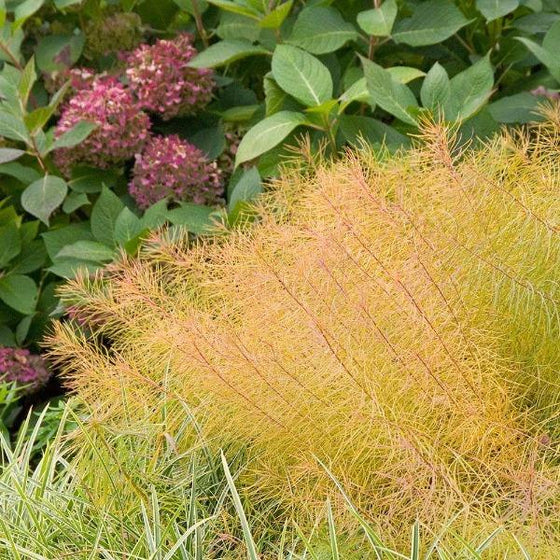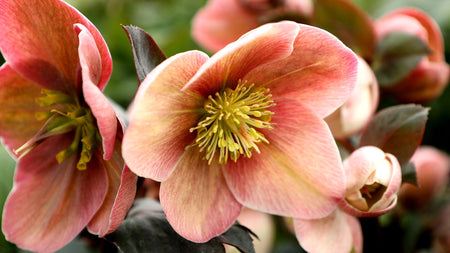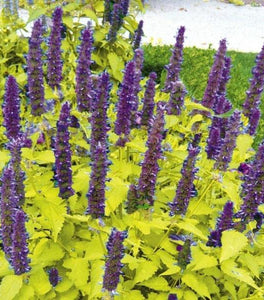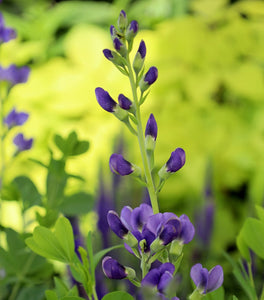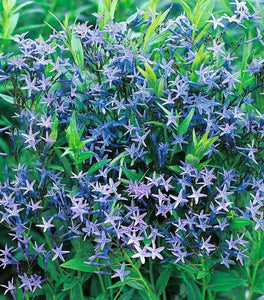
Images Depict Mature Plants
Amsonia Hubrichtii for Sale Online
Amsonia hubrichtii, also known as Arkansas Bluestar, is a versatile and eye-catching perennial prized for its delicate, feathery foliage and beautiful blooms. In late spring to early summer, Amsonia hubrichtii produces clusters of soft, powder-blue star-shaped flowers, creating a calming, ethereal effect in the garden. This perennial's bright green, thread-like leaves add a fine texture, making it a perfect complement to bolder, coarser plants in the landscape. As the seasons change, Amsonia hubrichtii truly shines with its stunning fall transformation—turning a brilliant golden yellow that lights up the garden with a warm autumn color.
Amsonia hubrichtii is well-suited for various landscape uses, such as borders, mixed perennial beds, and naturalized areas. Its airy foliage and soft blue flowers are an excellent choice for adding texture and visual interest to a garden. Reaching about 3 feet in height and width, Amsonia hubrichtii works well in mass plantings, forming an attractive mound that can serve as a striking backdrop for other flowering perennials. This low-maintenance perennial thrives in USDA hardiness zones 4 through 9, preferring full sun to partial shade and well-drained soil. It is also highly adaptable, tolerating a wide range of soil conditions, and is drought-tolerant once established, making it a resilient and practical choice for many garden settings.
In addition to its aesthetic appeal, Amsonia hubrichtii is deer-resistant and attracts pollinators like butterflies, making it a valuable addition to wildlife-friendly gardens. Its toughness and adaptability make it easy to care for, with minimal maintenance beyond regular watering during the first growing season and an annual cutback in late fall or early spring. Whether used as an accent, a groundcover, or a part of a larger planting scheme, Amsonia hubrichtii brings year-round beauty, texture, and seasonal color to the garden, making it an essential plant for creating a dynamic and visually appealing landscape.
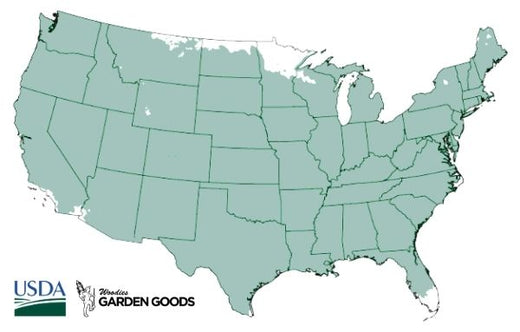
| Hardiness Zone: | 4-9 |
|---|---|
| Mature Height: | 2.5 to 3 feet |
| Mature Width: | 2 to 3 feet |
| Classification: | Perennial |
| Sunlight: | Full Sun |
| Habit: | Upright, clump forming |
| Flower Color: | Powdery Blue |
| Flowering Season: | Late spring through Early Summer |
| Foliage: | Green with excellent fall color |
| Soil Condition: | Prefers dry, average to sandy soil, wont tolerate wet soil in winter |
| Water Requirements: | Water well until established |
| Uses: | Extremely attractive when used as a focal point in the mixed border, mass planting. Attracts pollinators and hummingbirds. |
How to Care for Amsonia Hubrichtii
Be sure to read our planting instructions to ensure a healthy and happy Amsonia hubrichtii plant for years to come!
How do I Plant Amsonia hubrichtii?
Planting Amsonia hubrichtii begins with selecting the right location to ensure this perennial thrives and showcases its beauty throughout the seasons. Choose a spot in your garden that provides full sun to partial shade, as Amsonia hubrichtii performs best with at least 6 hours of sunlight daily, which helps promote more abundant flowering and a vibrant golden fall display. Well-drained soil is essential for avoiding root rot, so consider amending heavy clay with compost or sand to improve drainage. Begin by digging a hole twice as wide as the root ball and slightly deeper than its height. Place the plant in the hole, ensuring the top of the root ball is level with or slightly above the ground surface, then backfill with a mix of native soil and organic compost. Firm the soil gently around the base and water thoroughly to help establish good root contact. After planting Amsonia hubrichtii, consistent watering during the first growing season is crucial to encourage deep root development. Water the plant deeply once or twice a week, depending on weather conditions, to keep the soil evenly moist but not waterlogged. Once established, Amsonia hubrichtii is relatively drought-tolerant, reducing the need for frequent watering. Adding a 2-3 inch layer of organic mulch around the base of the plant helps retain soil moisture, suppress weeds, and regulate soil temperature. If you plan to plant multiple Amsonia hubrichtii for a mass planting effect, space them about 2 to 3 feet apart to allow for their natural, mounding form to spread and fill in over time. With proper planting and care, this low-maintenance perennial will reward you with delicate blue star-shaped flowers in spring and a striking golden display in autumn, adding multi-season interest to your landscape.
How do I water Amsonia hubrichtii?
Watering Amsonia hubrichtii correctly is key to ensuring this beautiful perennial thrives and showcases its lush foliage and seasonal blooms. During the first growing season, it is crucial to water Amsonia hubrichtii regularly to help establish a strong root system. Water deeply once or twice a week, depending on the weather and soil conditions, keeping the soil consistently moist but not waterlogged. Deep watering encourages the roots to grow downward, which makes the plant more drought-tolerant over time. It's best to water in the morning to allow the soil to dry before nightfall, which helps prevent potential fungal issues. If the plant is grown in well-drained soil, using a soaker hose or drip irrigation system is an efficient way to ensure consistent moisture reaches the root zone. Once Amsonia hubrichtii is well-established, it becomes more drought-tolerant and requires less frequent watering. During periods of extreme heat or prolonged dry spells, supplemental watering may be needed to maintain its lush appearance and promote healthy growth. Check the top 2 to 3 inches of soil—if it feels dry to the touch, it's time to water deeply again. In normal weather conditions, rainfall may be sufficient for established plants, especially in cooler climates. Mulching around the base of the plant helps retain soil moisture and minimize evaporation, which is particularly helpful during hot summer months. By following these watering guidelines, you can enjoy a healthy, thriving Amsonia hubrichtii with its soft blue star-shaped flowers and brilliant golden fall foliage, adding beauty and texture to your landscape throughout the growing season.
How do I Fertilize Amsonia hubrichtii?
Fertilizing Amsonia hubrichtii is not often required, as this hardy perennial can thrive in a variety of soil types without heavy feeding. However, for optimal growth and to encourage abundant blooms and vibrant fall color, you can apply a balanced, slow-release fertilizer in early spring, just as new growth begins. Choose a 10-10-10 or 12-6-6 blend to provide essential nutrients like nitrogen, phosphorus, and potassium that will support healthy foliage and flower production. Apply the fertilizer evenly around the base of the plant, extending out to the drip line, and be sure to keep it at least 6 inches away from the stems to avoid burning the roots. After fertilizing, water thoroughly to help the nutrients reach the root zone and enhance the plant's ability to absorb them. For gardeners seeking a more organic approach, Amsonia hubrichtii can benefit from the addition of compost or well-aged manure as an alternative to chemical fertilizers. Spreading a 1 to 2-inch layer of compost around the base of the plant in early spring enriches the soil with organic matter, helping to improve its structure and support consistent nutrient availability throughout the growing season. Mulching with organic materials, such as shredded leaves or bark, can also help retain moisture, suppress weeds, and gradually release nutrients into the soil. Avoid over-fertilizing, as excessive nitrogen can lead to excessive leaf growth at the expense of flowers. By providing the right balance of nutrients, Amsonia hubrichtii will produce its delicate star-shaped flowers in spring and turn a striking golden hue in autumn, making it an exceptional feature in your garden.

How do I Prune Amsonia hubrichtii?
Pruning Amsonia hubrichtii is a simple process that helps maintain the plant’s shape and promote healthy growth. The best time to prune Amsonia hubrichtii is in late fall or early spring, after the plant has gone dormant or before new growth begins. Once the stunning golden foliage of Amsonia hubrichtii fades in the fall, cut back the stems to about 6 inches above the ground. This helps to clean up the garden bed and prevent any potential pests or diseases from overwintering in the old foliage. Cutting back the plant also encourages vigorous new growth when the growing season begins again, allowing the perennial to produce fresh foliage and abundant blooms. During the growing season, Amsonia hubrichtii may also benefit from a light trim to maintain its attractive, bushy appearance. After the soft blue star-shaped flowers fade in late spring or early summer, lightly prune the plant to keep it compact and prevent it from becoming too leggy. Removing spent flower stems can also help direct the plant’s energy into foliage growth and enhance the plant's overall shape. When pruning, always use clean, sharp pruning shears to avoid damaging the plant and ensure smooth cuts. By incorporating proper pruning practices, Amsonia hubrichtii will maintain its graceful form and produce healthy foliage that transforms into a striking golden display each fall, adding interest to your landscape year-round.

